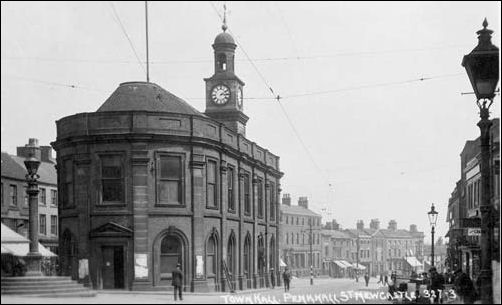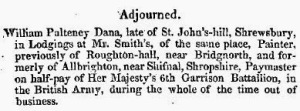At Whitmore in 1855 a man named William Rhead (1836 – 1904), aged 19, was charged with the manslaughter of Eliza Palmer (1834 – 1855), aged 21. He had shot her point blank in the face, but a jury found this to have been an unintentional act, and he was discharged not guilty.
The Staffordshire Advertiser reported
21 April 1855
SERIOUS ACCIDENT PROM FIRE-ARMS.--Another casualty, the result of frolicking with fire-arms occurred Whitmore on Saturday evening last, to Eliza, daughter of Mr. Thomas Palmer, farmer and butcher. It seems that the young woman, who is about 18 years of age, was engaged in domestic occupation in her father's house when a young man of the name of Rhead, employed at the Whitmore Railway Station, came in. Rhead took down a gun, and in a jocular manner (quite unconscious that it was loaded ) told Miss Palmer that he would shoot her ; upon which she told him to shoot, as she would not flinch. He then presented the gun at her and pulled the trigger, but it missed fire: a second time he pulled the trigger when the gun unfortunately went off, and the charge of shot entered the upper part of the left cheek, taking a direction, as is supposed, towards the brain. The young woman, who is dreadfully injured, was placed under the care of Dr. Ryan, and remained in most precarious state for some days; and, notwithstanding she is slightly better, her recovery is said to be somewhat doubtful.
5 May 1855
THE LATE ACCIDENT FROM FIREARMS AT WHITMORE,We regret to record that. Miss Palmer, daughter of Mr. PaImer, farmer and butcher, of Whitmore, who was accidentally shot in the face by a young man named William Rhead, employed at the Whitmore Railway Station, on the 14th of April, under circumstances detailed in our publication of the 2lst ult., died on Saturday morning. The young man, it will be remembered, presented the gun at her not knowing it was loaded, and asked her if he should shoot her. She replied, "Yes, if you like; I will not flinch." He pulled the trigger, and without effect; but unfortunately pulled it a second time, when it went off, and the whole of the charge lodged in the upper part of the left side of Miss Palmer's face, inflicting frightful injury. The unfortunate young woman lingered in great pain until Saturday morning last, when death terminated her sufferings. An inquest was held before W. Harding, Esq., on Monday, and again by adjournment on Tuesday evening, at the Sheet Anchor Inn. The father, mother, and sister of the deceased, and other witnesses (including Dr. Ryan, who had attended upon the unfortunate deceased), were examined. Dr. Ryan stated that, on a post mortem examination, he found a charge of shot on the cavity of the temple bone, on the left side. He extracted about eight or ten shots, but there were more on the temporal bone he did not extract. At the time the gun was discharged he considered the muzzle must have been very close to the deceased. The cause of death was inflammation of the brain, caused by the gun-shot wound. The coroner having summed up the evidence, the jury were unanimous in considering Rhead highly culpable in not first ascertaining that the gun was charged before he pulled the trigger, and returned a verdict of " manslaughter" against him. Mr. D.S. Sutton attended to watch the case on behalf of Rhead; who was also committed for trial on the same charge after an examination before the county magistrates sitting in the Guildhall, Newcastle, on Wednesday. The prisoner was liberated on bail.

The Guildhall was built in 1713. Originally the ground floor was open and was used for markets. In 1860, in order to provide more space, the ground floor arches were bricked up and clock tower with four clocks were added. The top rooms in the Guildhall were used for meetings by the Borough council and its committees, until 1860.
Early 20th century postcard from Neville Malkin’s “Grand Tour” of the Potteries buildings in and around Newcastle-under-Lyme: No 23 – The Guildhall, Newcastle
William Rhead was tried at the Staffordshire Summer Assizes before Mr Justice Erle.
Assizes were periodic courts held around England and Wales until 1972, when together with the quarter sessions they were abolished by the Courts Act 1971 and replaced by a single permanent Crown Court. The assizes exercised both civil and criminal jurisdiction, though most of their work was on the criminal side. The assizes heard the most serious cases, most notably those subject to capital punishment. Other serious cases were dealt with by the quarter sessions (local county courts held four times per year), while the more minor offences were dealt with summarily by justices of the peace in petty sessions (also known as magistrates’ courts).

By Staffordshire County Council CC BY-SA 3.0, retrieved from Wikimedia Commons
28 July 1855
DISTRESSING CHARGE OF MANSLAUGHTER AT WHITMORE.
WILLIAM RHEAD, 19, a plate-layer (on bail), was arraigned on a charge of the manslaughter of Eliza Palmer, at the parish of Whitmore.
Mr. NEALE conducted the prosecution ; Mr. KENEALY defended the prisoner.
Mr. NEALE opened the case to the jury. The learned counsel observed that the prisoner was charged with the manslaughter of a young woman named Palmer, the circumstances of which were, that on the 2nd of April, the prosecutor, a farmer and butcher, went out Into his fields with a gun, which having tried to discharge without effect, he brought home and put it in the kitchen. Fourteen days afterwards, the prisoner, who was a plate-layer on the London and North-Western Railway, went on a visit to Mr. Palmer's house, when he took down the gun, admired it, and pointed it at one of the daughters. The mother, when he took down the gun, begged him to be cautious ; he, however, appeared not to heed what she said, but asked the daughter whether he should fire, to which she replied, “Yes; fireaway; I will never flinch.” Now, it would be necessary for them to consider whether, with such an observation or invitation as that, it might have given the prisoner an assurance or an impression that the gun could not be loaded. The prisoner snapped the gun, but it did not go off; and he was about to snap it again, when she said, “Nay, lad ; if you cannot shoot me at once, you shan't shoot me at twice.” He, however, pulled the trigger again, the cap exploded, and the contents of the gun lodged in the face of the unfortunate young woman. She lingered a fortnight in the greatest pain, and then died; but before, and with her dying breath, and whilst the police were looking after the prisoner, she made a very touching request to her parents that no proceedings should be taken against him, as she was satisfied that the rash act was unintentional on his part. The learned counsel then called Mr. Thomas Palmer, who stated that he was a farmer and butcher living at Whitmore. On the 2nd of April, whilst going into a field of oats on his farm, he saw his gun placed against the gate, which he took up, and examined as to the weight of the charge. He then snapped the cap, but it did not go off. He left the cap on the nipple, and took the gun into the house and hung it up in the houseplace. On the 14th April he had been from home, and he returned about half-past eleven o'clock at night, when he was informed of the lamentable accident which had happened.
Cross-examined.-—He had been told that the prisoner used the gun at Christmas to fire at the candle ; he knew the prisoner very well ; he had always borne a very good character; he (witness) had always hung up the gun unloaded previously.
Sarah Palmer deposed that she was mother of the deceased; she remembered the evening of the 14th of April ; she was in the kitchen with the prisoner and her daughter, when the prisoner took down the gun ; she (witness) said, “don't, Will, I detest the look of a gun, and always did." The prisoner said, “Eliza, shall I shoot you," to which she replied, "Yes.” He then said, "Will you stand?” and she answered, “Yes, and never flinch.” He then snapped the gun, and it missed fire. He was doing so again, she said, “If you cannot do it the first time you shan't try again.” The gun was discharged, and her daughter fell wounded.
Cross-examined.—The prisoner said, when he had the gun in his hand, “Bless you, do you think I shall harm her.”
Mr. KENEALY, who very briefly addressed the jury on behalf of the prisoner, submitted that there was not that careless negligence apparent which would justify them in finding a verdict of guilty ; and contended, from the intimacy which existed between the prisoner and deceased, and the high respect in which he was held by the family. that the unfortunate result of the rash act was perfectly unintentional.
His LORDSHIP summed up the evidence, observing that although he thought upon reading the depositions that the prisoner had taken down the gun without any previous knowledge of it, the investigation of the case materially altered that view, it having been shown that the gun was habitually placed in the houseplace unloaded, of which the prisoner was fully aware, which circumstance it was necessary for them to consider in their verdict.
The Jury returned a verdict of not guilty, and the prisoner was immediately discharged.
The Palmer family seems not to have held a grudge against William for the death of Eliza. Five years later, on 27 December 1860, he married Eliza’s sister, Cecelia (1841-1889). They had nine children. William, promoted from plate-layer to fireman, became an engine driver.
Wikitree:
- William Rhead (1836 – 1904)
- Eliza Palmer (1834 – 1855)
- Thomas Palmer (1810 – 1867), Eliza’s father
- Sarah Anne (Atkinson) Palmer (1810 – abt. 1878), Eliza’s mother
- Cicely or Cecelia (Palmer) Rhead (1841 – 1889), Eliza’s sister and William’s wife




































